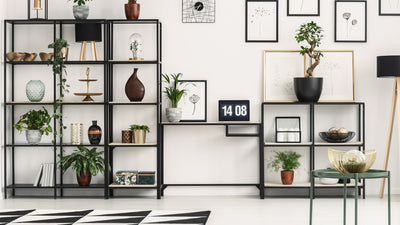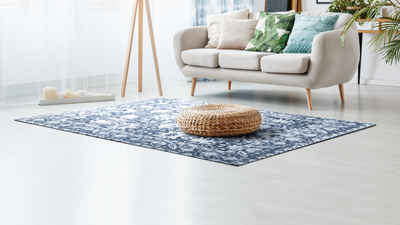What is Art Deco interior design?
Art Deco refers to a style of interior design that was popular between 1919 and 1940, losing momentum just before World War II. If you’ve ever imagined yourself in the Great Gatsby mansion, then you’ve dreamed of an Art Deco period home. The style encompasses the vibrancy and livelihood of the 1920s through geometric shapes, bold colours, pointed edges, revised ancient motifs, symmetrical patterns, decorative arts and over-the-top glitz and glam. It is considered one of the first global design styles and its influence can still be seen today in famous architecture, artworks and more.

Art Deco interior design is experiencing a resurgence thanks to the revival of vintage fashion and design. While genuine vintage art deco furniture, decor and pieces may be out of reach for your budget, plenty of brands are reproducing classic pieces in the style and bringing them into the modern era. If you want to experience the fun and frivolity this style has to offer, read on.
The History of Art Deco Style
Art Deco first appeared in the 1910s (approximately two years before World War I), flourished in the 1920s and continued to develop until the start of World War II. The style was partially influenced by ancient design (as seen in classic uses of the sunburst motif), sparked by the discovery of Tutankhamun’s tomb in 1922, but it was mainly focused on themes such as wealth, glamour, modernity and innovation. The age of Art Deco was also the age of streamlining, flappers, jazz and cubism, all of which influenced what we consider Art Deco design today.

Despite it technically appearing before World War I, experts seem to agree that the war had a massive influence on the art form. Immediately coming out of the war, people were eager to put the tragedy behind them and look towards the future. The US also experienced a brief economic growth spurt, leading to great Art Deco architectural feats such as the Chrysler Building. It was a period characterised by exuberance and luxury. When the Great Depression hit in 1929, Art Deco became less expensive and grand but no less interesting, substituting affordable materials and more pragmatic designs. It also birthed a style of Art Deco called Streamline Moderne, which expressed the speed at which modern life was accelerating through smooth, rounded corners and decorative speed bands which created a streamlined look.
Key elements of Art Deco design
Defining Materials
Exotic materials
Mahogany, animal skins (especially shark and safari animals such as zebra), ebony and ivory are just some of the exotic materials used in Art Deco interior design. These materials were bold, exciting and glamourous, but they were also very expensive, which meant they were overtaken by other common materials during the Great Depression (over the 1930s).
Plastic
Bakelite was the first synthetic plastic and was widely used thanks to its unique properties. It is non-conductive and heat resistant, making it ideal for everything from electrical insulators to kitchenware and jewellery. These properties and affordability made it a popular material during the Art Deco period. In the late 1920s, new plastics such as Catalin were produced that were easier to mould and produce in more stable, bold colours.
Metals
Stainless steel, chrome, gold and platinum became more popular as they became more widely available. The bright and shiny finishes were perfect for this era where imaginations had been captured by the glistening golds unearthed in ancient Egypt.
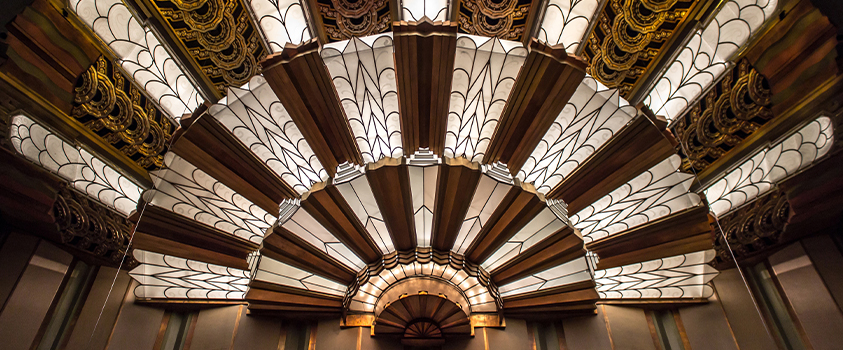
Glass
As more techniques were developed for working with glass, it became one of the most versatile and popular materials of the modern era. Colourful, thick glass pieces were popular, and glass was widely used in lighting.
Reinforced concrete
This type of concrete is often made by embedding steel bars into the concrete prior to setting, preventing structural failure. It was heavily used in construction during this time thanks to its durability and cost-effectiveness.
Precious stones
Jewellery made from precious metals and stones were incredibly popular during the era of Art Deco, especially thanks to the unveiling of Tutankhamun’s golden treasure-filled tomb. Pierre Cartier predicted the tomb’s discovery would influence fashion in jewellery, which was self-fulfilled when Cartier released an Egyptian Striking Clock in 1927. The introduction of platinum in the 1930s also aided the production of affordable costume jewellery.
Popular Motifs
Generally speaking, a motif is a repeated image, symbol, pattern or idea. Art Deco has many memorable motifs that help define the style. These motifs symbolised the dawn of a new age (and a new day), prosperity, optimism, and excitement for the future.
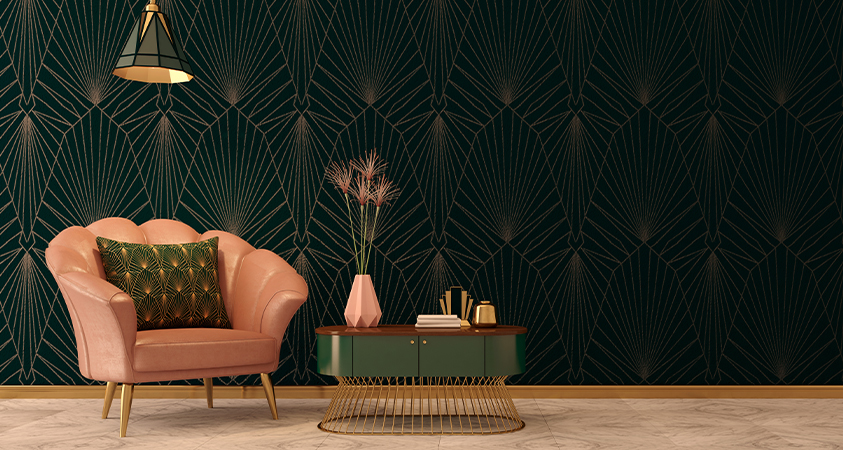
Common Art Deco motifs and elements to look out for include:
-
Chevrons
-
Zigzags
-
Sunbursts
-
Fans
-
Flowers
-
Stylised women
-
Aerodynamic curves
-
African influence
-
Ancient civilisations
Common Colours
Like with much of Art Deco, when it came to colour it was go bold or go home. Some popular colours included bright and deep yellows, reds, blues, greens, oranges and pinks. These could be used alongside neutral colours from beige to medium brown, making polished wooden furniture a popular choice. Metallics were also popular and often used as an accent.
Examples of Art Deco Interior Design
Art Deco Bedroom

These gorgeous Art Deco-inspired bedrooms are located in the Belgravia Gallery wing of the Hydro Majestic hotel in the Blue Mountains, New South Wales, Australia. These rooms are described as “a seamless blend of art deco inspired design with a black and white colour scheme” as well as modern amenities. Looking at the rooms, you can see luxurious velvet studded wingback chairs, leather tufted chairs and headboards, bold yellow and black throw pillows, luxurious white bedding and metallic gold accents against beige walls. Dripping with glamour, these rooms are a great example of art deco applied in a modern setting.
There are plenty of ways you can upscale your bedroom at home for an inspired Art Deco look.
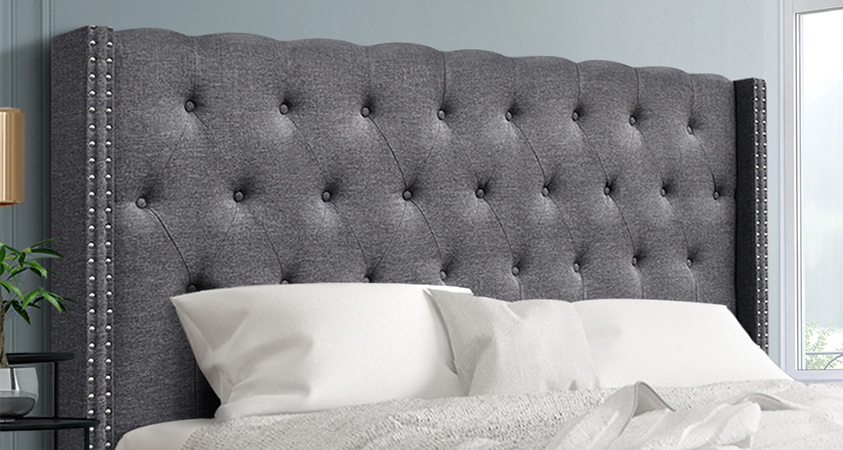
A glamorous headboard
Adding a headboard to your bed is an easy way to add luxury to your bedroom decor. For maximum glamour, choose a tufted or studded headboard such as the timelessly chic Luca Winged Bedhead from Artiss. Perfectly suited to an Art Deco bedroom, you can use this plush bedhead to sit up and relax while reading, watching TV or enjoying breakfast in bed.
A decorative sconce
A sconce is a light fixture that attaches to a wall. An art deco sconce may have elements of a sunburst, fan or geometric design and may be made out of materials like frosted glass and chrome or other metals. These will offer general mood lighting and give your bedroom a warm cosy lighting foundation.
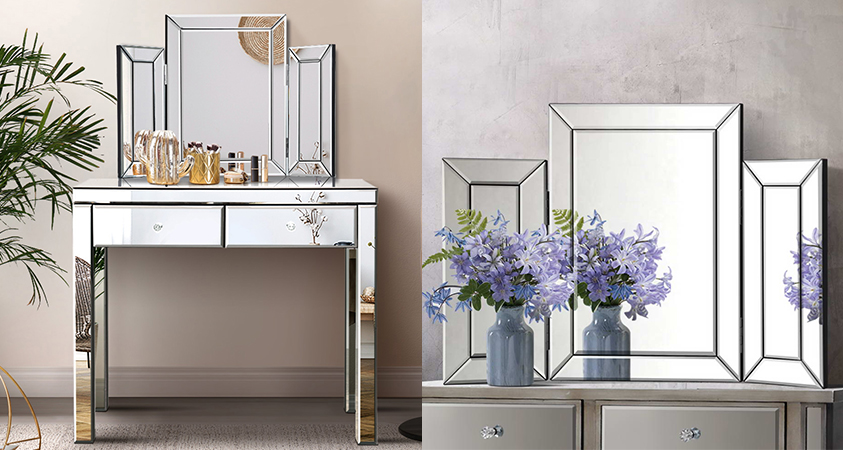
An ornate vanity (with a mirror)
Nothing says “beautiful” like a little self-care, and nothing says self-care like a bedroom vanity with Art Deco flair. Have your entire morning routine at the tip of your fingers with a dressing table set that will set your bedroom decor apart. Artiss Dressing Table sets can be tailored to your individual decor tastes. Repurpose one of our provincial dressing table sets by painting it black, pink, or any other bold colour. Want something more high-glam? Our mirrored vanity/console table will really make a statement, or you can even add the mirror separately.
LARGE RUGS
Is there any better feeling than sinking your feet into a plush, warm floor rug? A large rug slipped under your bed is a great way to elevate your decor and add instant comfort. Ideally, the rug should extend at least ¾ of the way under the bed, if not all the way to the headboard. It should also extend all the way under the bedside tables on either side give or take 10cm. If you have a reading nook in your bedroom, you might want to consider a small rug under these furnishings too. For an eye-catching floor rug that evokes Art Deco vibes, check out our Tria geometric rug or you can read our blog How to Pick the Perfect Floor Rug for your Space.
SymmetrICAL DESIGNS
Art Deco style values symmetry, even in its abstract patterns. Use the bed as a focal point and build your decor from there. A bedside table on each side, matching artwork above the headboard, and a decorative pillow arrangement are all ways you can express symmetry in your bedroom.
Art Deco Living Room
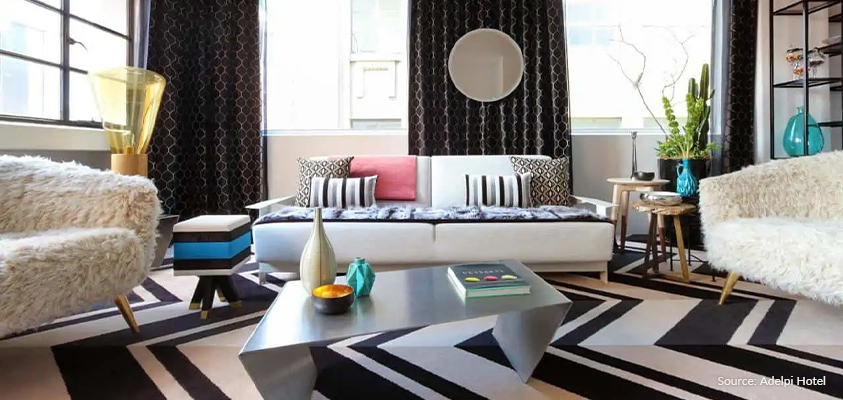
This excellent Art Deco interior comes from the Adelphi Hotel in Melbourne. Another modern take on Art Deco that prominently features black and white, this living space also uses bright blues, soft furnishings and natural wood textures, and clean lines to create a sharp, bold living space. Note the hexagonal gold and black patterned curtains, plush textiles, zigzag rug, chrome table, orange glass light fixtures and fun licorice allsorts style ottoman.
For an Art Deco look in your living room, consider the following features.
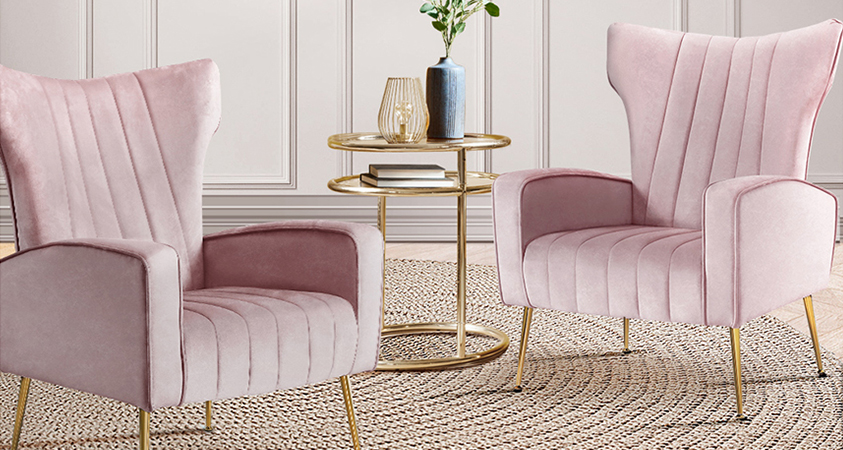
Luxury occasional seating
Accent or occasional chairs are more decorative than your average armchair, but that doesn’t mean they’re not also useful. For an Art Deco style living room you should choose a chair with decorative accents such as the Artiss Oliver armchair with its silver studded trim. For something a little more colourful, the Kate armchair comes in a variety of colours and features a streamlined design and golden legs for that extra glitz and glam.
A full area rug
An area rug is designed to cover your entire room, or at least as close as you can get. Area rugs help the room to feel proportioned and your furniture anchored, creating a cosy focal point for your guests to turn to and feel welcome. Area rugs are perfect for every living room, but especially an Art Deco living room where opulence is key. Choose a bold patterned rug that matches the colour of your existing decor. A high pile shag rug is perfect for ultimate comfort, but a short pile rug will be better for showing off patterns and are easier to clean and maintain, especially if you have pets, children or allergies. For more tips on choosing the right living room rug for you, check out our blog How To Choose The Right Sized Rug for your Living Room.
Art Deco decor To The Max
Maximalism is all about showing off your life in objects. It embraces curated excess, which is perfect for an Art Deco-inspired space that enjoys fun, frivolity and wealth. When choosing items to display in your Art Deco living room, more is better. Think metallic statues, geometric patterns, dramatic artworks and vintage finds like an Art Deco vase.
Show art everywhere
Speaking of art, you should have as much as possible. Where there’s wall space, there’s potential for art. To make the most out of your empty wall space, read our blog How to Create a Gallery Wall and check out our wide range of multipurpose photo frames.
Art Deco Dining Room
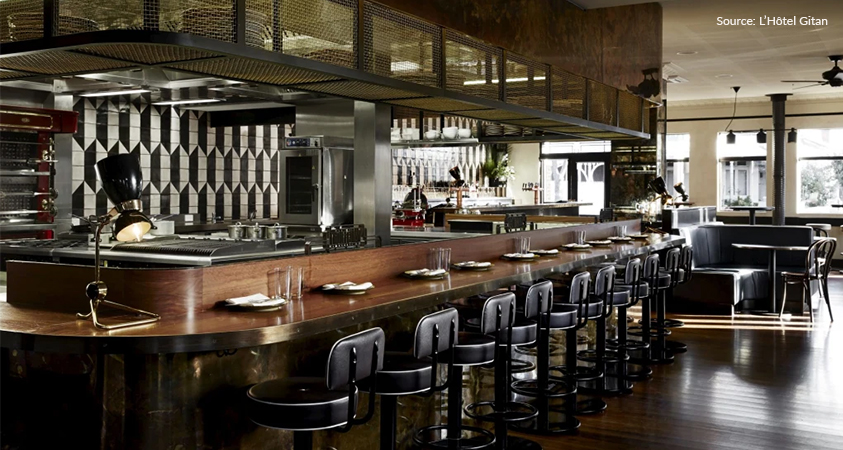
While a restaurant may differ from a private dining room, you’ll find plenty of inspiration for your home from L’Hôtel Gitan, a French restaurant in Melbourne set inside genuine Art Deco architecture. The restaurant features hand-placed Art Deco style tiles, an open kitchen with a large display of copper pots and pans, a seated bar with an antique bronze finished brass plate, stained glass, decorative sconces and chandeliers. The space is full of earthly tones and metallic accents, and slow curves abound. All these elements together pay tribute to the age of Art Deco design in a playful, intimate, modern way.
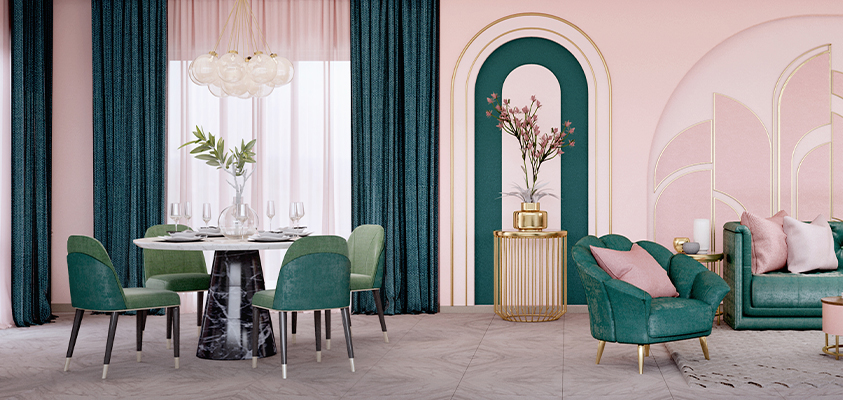
You can enjoy Art Deco style in your dining room with a few simple touches.
An attention-grabbing light fixture
All dining rooms need great lighting. The perfect ice breaker, your dining table will be the talk of the town with an eye-catching chandelier, tall candle arrangements, or stylish sconces.
AESTHETIC accent walls
An accent wall helps to anchor a room and provide a little excitement. You can use it to tie together a room’s colour scheme or simply provide a decorative boost. Choose jewel tones in dark hues for an even more dramatic look.
A dynamic dining table
Why go boring when you could go Art Deco? Invest in a dining table that shouts decadence. Not sure where to start? You can design your own table from scratch with Artiss. Simply bring your own tabletop and combine it with our exciting retro classic starburst, industrial V-shaped or trapezoid table legs. For maximum impact consider marble, dark wood, or even resin tabletops.
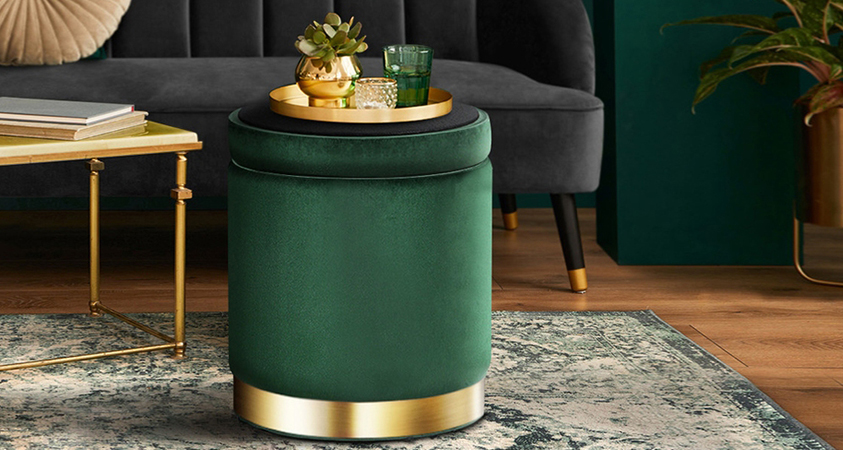
If you’re considering adding some Art Deco-style furnishings to your home, check out our latest online stash. We have amazing modern Art Deco pieces to suit your home including storage ottomans, bed frames, room dividers and wall art. Looking to redecorate but not sure if Art Deco decor is for you? Check out our blog 17 Popular Interior Design Styles for Your Home for even more styling tips. Create your dream home in just a few clicks by visiting the Artiss website.
Art Deco Interior FAQs
What is the difference between Art Nouveau and Art Deco?
Both genre-defining art movements of the 20th century, Art Nouveau and Art Deco sound similar but are actually completely different.
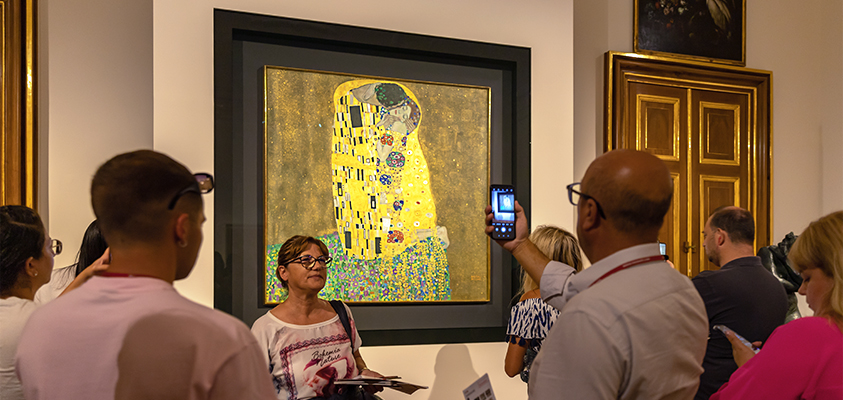
Art Nouveau developed towards the end of the 19th century as a response to both the Industrial Revolution and historicist revivals of the 19th century. Art Nouveau draws inspiration from organic forms and natural imagery and celebrates human craftsmanship and artistry while also embracing aspects of the industrial age such as the use of modern materials like glass and iron. It was a style that turned from the past and looked towards the present and future. It is a movement characterised by smooth lines and curves, bends and asymmetry, where women are depicted with long flowing hair and plants, flowers, insects and even mythical motifs such as fairies feature prominently. Famous examples of Art Nouveau includes Gustav Klimt’s The Kiss, the whiplash curve motif, Otto Wagner’s Church of St Leopold in Vienna and The Peacock Skirt by Aubrey Beardsley. The movement goes by many names, but the Art Nouveau label is often credited to the Parisian art gallery La Maison de L’art Nouveau, one of the first galleries to publicly display large collections of art in this style.
Art Deco emerged just before World War I and is much more streamlined, with a focus on geometrical shapes, bold colours, sharp lines and themes of wealth and innovation. The name is often credited to another Parisian event, the Exposition Internationale des Arts Décoratifs et Industriels Modernes, held in 1925.
Is Mid-century Modern the same as Art Deco?
Mid-century Modern and Art Deco interior design don’t share similar names, but it can be confused due to their similar love of colour, clean lines and modern materials.
The Art Deco design period came before World War I and embraced the idea of a golden age of design and architecture. It was characterised by wealth, opulence, geometric patterns and exotic modern materials. Colours were bold and patterns often made use of smaller, repetitive elements and geometric shapes.
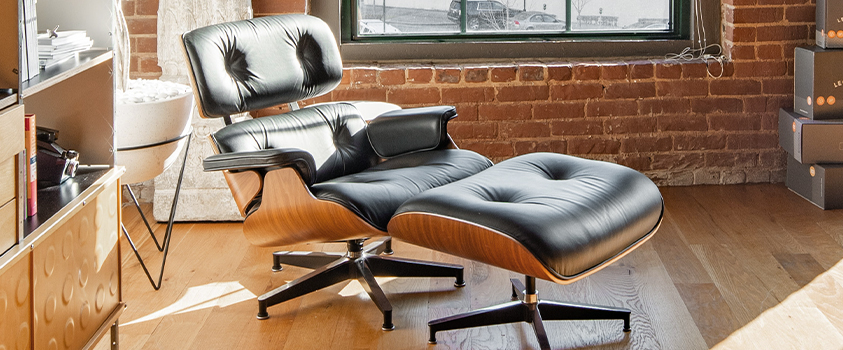
Mid-century Modern emerged out of World War II and one of the main principles was “form follows function”. This phrase was coined by Louis Sullivan and means that the purpose of a building/furniture piece should be the starting point for its design. This style was characterised by a need to rebuild after the war despite a lack of resources. Pieces needed to be easy to manufacture, affordable to buy, and designed to boost morale. Where geometric shapes and clean lines are staples of Art Deco interior design, Mid-century Modern used them more sparingly and also incorporated organic shapes and colours. Plastic and composite woods were popular materials around this time. Above all, there was a focus on practicality, leading to classic designs such as the Eames chair, Kenwood mixer and Helvetica font.
Is Art Deco maximalist?
While Art Deco interior design isn’t always maximalist, it is certainly tied to this style of decorating. Where minimalism is about getting rid of excess and keeping only what you need, maximalism is about showing off your favourite pieces, over-the-top decoration, and bringing vibrancy and joy to your home.
Common features of maximalism include bold colours, eclectic furniture designs, abstract art and a general sense of grandeur. As a grand design style, Art Deco fits nicely into this movement. Whether you’re seeking genuine vintage Art Deco pieces or embracing the style with modern Art Deco replicas, the fiercely unique details of this art movement are perfect for a maximalist home.








